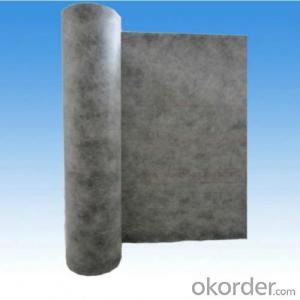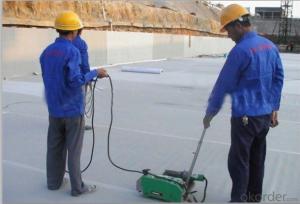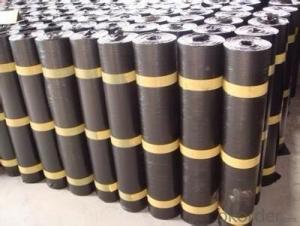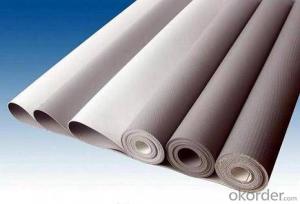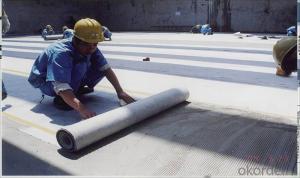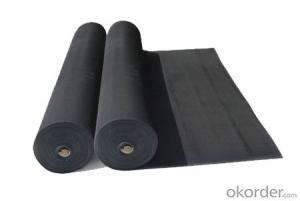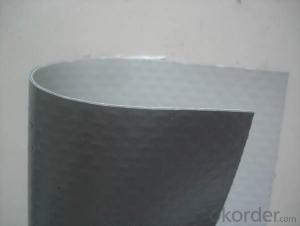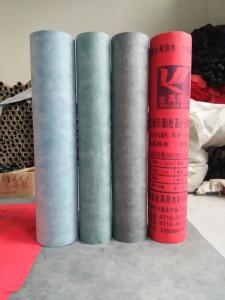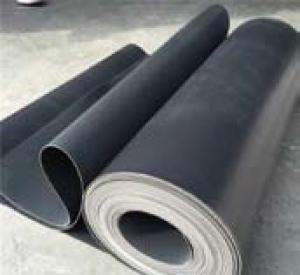High Polymer Waterproof Membrane
- Loading Port:
- China Main Port
- Payment Terms:
- TT OR LC
- Min Order Qty:
- -
- Supply Capability:
- -
OKorder Service Pledge
OKorder Financial Service
You Might Also Like
This product is composed of extruded PE membrane with polypropylene fiber or dacron and self-adhesive covered on both sides of the core membrane as reinforced layer to make it big friction and easy to be stuck firmly to the concrete. With characteristics of easy installation, no pollution and good durability.
Polyethylene polymer waterproofing materials performance index
GB 18173.1-2006
Items | FS2 Resins | Applicable Test Category | |
Tensile Strength(N/cm) | Normal temperature≥ | 60 | GB6.3.2 |
60°C≥ | 30 | ||
Elongation% | Normal temperature≥ | 400 | |
-20°C | 10 | ||
Tear Strength ( N) | ≥ | 20 | GB6.3.3 |
(0.3Mpa.30 min)Water impermeability | No leakage | GB6.3.4 | |
- Q: The shortcomings of polypropylene waterproofing, and the shortcomings of modified asphalt waterproofing membrane
- The advantages of the membrane waterproof, such as: the construction is convenient, the construction period is short, not need to be cured after forming, is not affected by the temperature, the environmental pollution is small, the layer thickness is easy to hold and hold the fortification meter, the material is calculated accurately, the site management is convenient, Cut corners, even thick layer, empty shop can effectively overcome the grass-roots stress (effective in the grass-roots cracks to maintain the overall waterproof layer).
- Q: Can a waterproofing membrane be used for bridges or viaducts?
- Bridges or viaducts can benefit from the use of a waterproofing membrane. These structures endure various weather conditions, such as rain, snow, and humidity, which can cause harm if not adequately protected. The purpose of a waterproofing membrane is to create a barrier against water infiltration, preventing moisture from seeping into the structure. By doing so, it safeguards the concrete or steel components, minimizing the risk of corrosion and other forms of deterioration. Moreover, the application of a waterproofing membrane can prolong the lifespan of the bridge or viaduct, resulting in reduced expenses for maintenance and repairs over time.
- Q: Is a waterproofing membrane breathable?
- No, a waterproofing membrane is generally not breathable as its primary purpose is to prevent water from passing through.
- Q: Can a waterproofing membrane be used in commercial construction?
- Yes, a waterproofing membrane can definitely be used in commercial construction. In fact, it is often a critical component of commercial building projects to protect structures from water intrusion and potential damage. Waterproofing membranes are designed to create a barrier against moisture and can be applied to various areas such as roofs, basements, foundations, and walls, ensuring a watertight and durable building envelope.
- Q: Can a waterproofing membrane be used in areas with high levels of salt or saltwater exposure?
- Indeed, areas with high levels of salt or saltwater exposure can benefit from the utilization of a waterproofing membrane. Nevertheless, it is imperative to opt for a membrane specifically engineered to endure these particular conditions. There exist certain waterproofing membranes that are specially concocted to resist the harmful effects of salt and saltwater exposure, effectively thwarting any potential harm or deterioration. Typically, these membranes are crafted using corrosion-resistant materials that possess heightened durability. To guarantee long-term efficacy and protection, it is absolutely crucial to seek professional guidance in selecting the appropriate type of waterproofing membrane for areas prone to high salt or saltwater exposure.
- Q: Is a waterproofing membrane resistant to abrasion?
- Yes, a waterproofing membrane is generally resistant to abrasion. Waterproofing membranes are designed to provide a protective barrier against water and moisture intrusion. They are typically made from durable materials such as PVC, TPO, or EPDM, which have high resistance to abrasion. This allows them to withstand the normal wear and tear that may occur during installation or due to foot traffic or other mechanical activities. However, it is important to note that the level of abrasion resistance can vary depending on the specific type and quality of the membrane, as well as the conditions in which it is installed or used. Therefore, it is always recommended to consult the manufacturer's guidelines and specifications to ensure proper selection and installation of a waterproofing membrane.
- Q: Are waterproofing membranes suitable for stadium structures?
- Waterproofing membranes are well-suited for stadium structures. Stadiums are exposed to different weather conditions, such as rain, snow, and humidity, which can potentially harm the structure if proper waterproofing measures are not taken. By providing a protective layer that prevents water infiltration, waterproofing membranes safeguard the stadium from moisture-related problems like leaks, mold, and corrosion. Water accumulation on large roof areas and expansive seating areas is common in stadium structures, making waterproofing essential. Membranes can be applied on various surfaces, such as concrete, metal, and wood, offering a versatile and effective waterproofing solution for stadiums. Furthermore, waterproofing membranes offer durability and longevity, which is crucial for stadiums that experience heavy usage and constant exposure to the elements. They are designed to withstand thermal expansion and contraction, as well as UV radiation, ensuring long-term protection for the structure. Moreover, architects and engineers can customize waterproofing membranes to meet specific design requirements, seamlessly integrating them into the stadium's overall aesthetic. These membranes come in various colors, textures, and finishes, allowing them to blend with the surrounding materials and enhance the stadium's visual appeal. In conclusion, waterproofing membranes are a reliable and effective solution for protecting stadium structures from water damage. They provide durability, versatility, and customization options, making them suitable for any stadium construction or renovation project.
- Q: Are there any specific tools or equipment required for installing a waterproofing membrane?
- Yes, there are specific tools and equipment required for installing a waterproofing membrane. Some common tools include a trowel, utility knife, paint roller, brush, and caulking gun. Additionally, a heat gun or torch may be needed for certain types of membranes that require heat activation. It is important to follow the manufacturer's instructions and recommendations for the specific membrane being installed to ensure proper installation and effectiveness.
- Q: Can a waterproofing membrane be used for green roofs?
- Indeed, a fundamental element of green roofs is the utilization of a waterproofing membrane. This membrane serves as a vital part of the green roof system, alongside a layer of vegetation and growing medium. Its primary purpose is to prevent any water infiltration into the building. Acting as a protective barrier, the waterproofing membrane shields the underlying structure from potential water damage. Its design is specifically engineered to endure continuous exposure to moisture and ensure no water permeates through to the building. Moreover, the membrane aids in retaining water within the green roof system, facilitating appropriate drainage and irrigation. As a result, the inclusion of a top-quality waterproofing membrane is indispensable for the successful installation and operation of a green roof.
- Q: Can a waterproofing membrane be used to repair existing water leaks or damage?
- Repairing existing water leaks or damage can be achieved by using a waterproofing membrane. These membranes are specifically designed to form a barrier that stops water from penetrating surfaces like roofs, walls, or foundations. When applied to areas where water leaks or damage have occurred, the waterproofing membrane effectively seals off the affected region, preventing further water intrusion. However, it is crucial to understand that the success of the repair relies on the extent of the damage and the quality of the chosen waterproofing membrane. It is highly recommended to seek professional advice to assess the situation and determine the most appropriate course of action for fixing existing water leaks or damage.
Send your message to us
High Polymer Waterproof Membrane
- Loading Port:
- China Main Port
- Payment Terms:
- TT OR LC
- Min Order Qty:
- -
- Supply Capability:
- -
OKorder Service Pledge
OKorder Financial Service
Similar products
Hot products
Hot Searches
Related keywords
